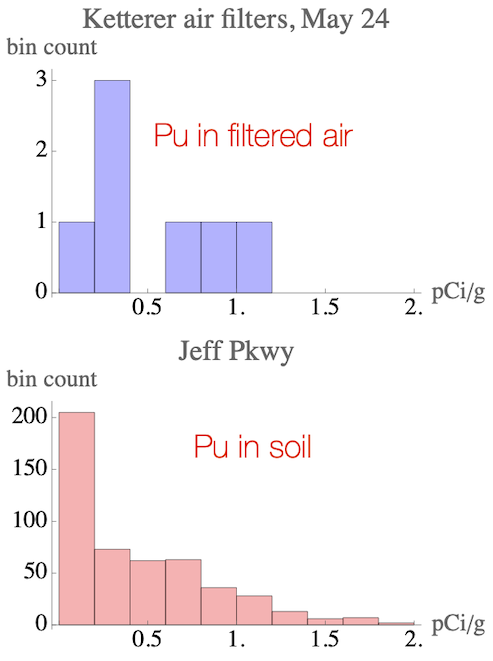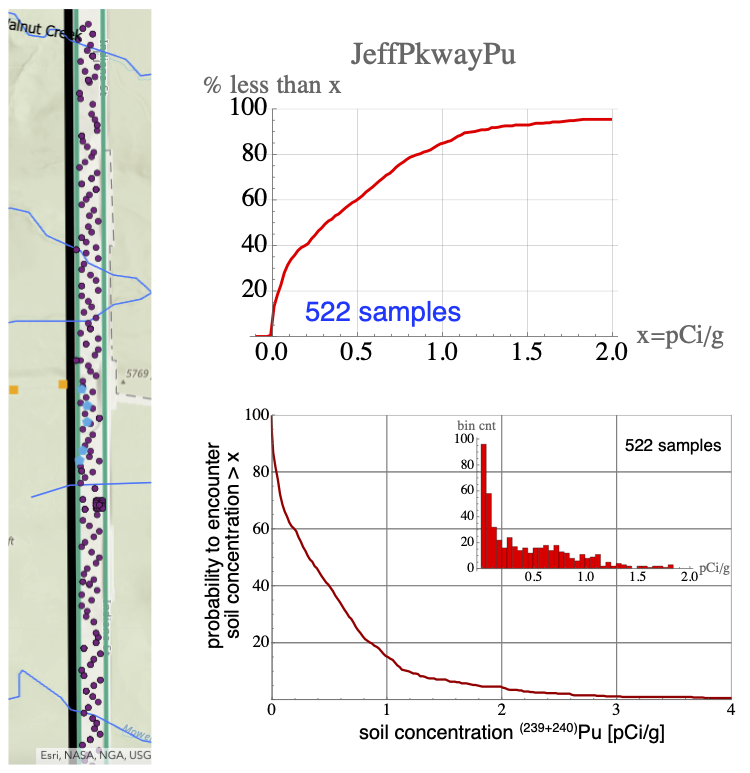Ketterer’s May 2024 air sampling nothingburger
December 2024: A technical summary can be found here.
[I downloaded a somewhat fuzzy .jpg from RockyFlatsPuPlayground here. A cleaned-up PDF is on our website here.]
Michael Ketterer and Jon Lipksy collected air samples at the former plant east gate on Indiana St, at the Refuge southeast Refuge gate, and at Colorado 128 at the Rock Creek underpass on a very windy day (April 6, 2024). The highest of 6 samples along Indiana was 1.19 pCi/g of (239+240)Pu. This value is completely compatible with what was measured on the eastern Refuge boundary during 2019 for the Jefferson Parkway. The sampling results confirm that it is very reasonable to use SOIL values in pCi/g in order to estimate what is in inhaled or ingested dust.
Desired response from an unsophisticated reader: OMG there’s PLUTONIUM in the air!
Ketterer’s specialty is measuring radioisotopes known as actinides. He didn’t mention: there is about 19.2 pCi/g of all-natural alpha emitting isotopes whose health impact is identical to that of plutonium (and 32.9 pCi/g of all-natural beta emitting isotopes) in dust suspended in the air as well.

We also know the statistics from the 2019 sampling: the peak value Ketterer and Lipsky found is close to what DMW used for annual radiation dose calculations in the 4-page May 2024 flyer. We found that about 90% of the 522 Jefferson Parkway samples were below the Ketterer/Lipsky value. Annual radiation doses from inhaled and ingested plutonium and americium are also reported in the flyer.

Left: sampling locations for Jefferson Parkway, 2019. Top right: percent of samples with (239+240)Pu concentrations above the x value. Bottom right: histogram of measured values (inset). To extent that sampling is representative, the average probability to encounter soil concentrations above x (pCi/g) within the right of way.
Encouraging more usage and land disturbances in the “Krey-Hardy plume” contaminated areas of the Refuge and/or COU will accelerate the rate of soil loss, and ultimately result in increased deposition of Rocky Flats plutonium-contaminated soils and particles towards receptor areas.
Such transport by wind was included 30 years ago during pre-cleanup research.
The takeaway: Ketterer has once again confirmed that what is measured NOW is consistent with what was measured and modeled even before the cleanup began. The idea that Pu is present in windblown dust is somehow new or unexpected is an attempt to raise alarm just in time for more local city council votes about Rocky Mountain Greenway extensions.